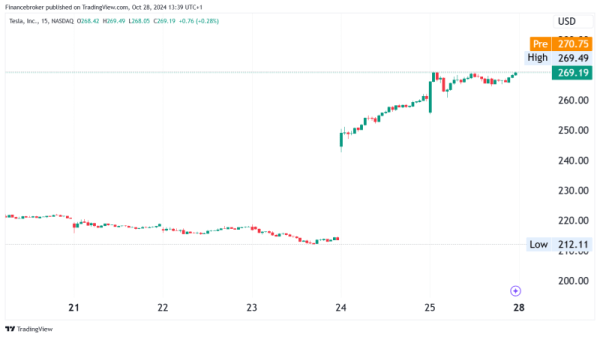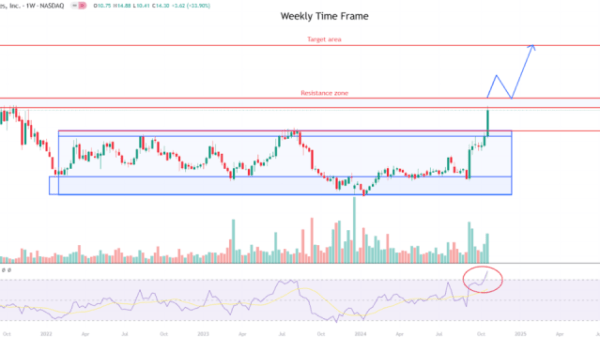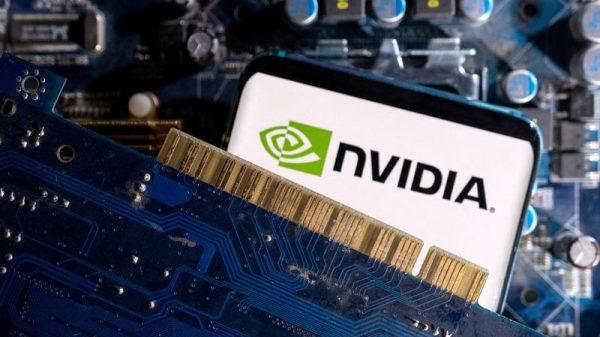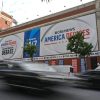In its Third Quarter 2024 Earnings Conference Call, onsemi (ON) revealed a slight revenue increase to $1.76 billion, marking a 2% sequential growth. However, the company faced challenges with year-over-year declines in automotive and industrial revenues. Despite a muted demand environment, particularly in North America and Europe, onsemi’s silicon carbide and ADAS image sensors drove a 5% sequential increase in automotive revenue.
The company’s commitment to operational excellence was underscored by a 41% sequential rise in free cash flow and the return of 75% of this flow to shareholders, including $200 million in share buybacks.
Key Takeaways
onsemi reported a 2% sequential revenue increase to $1.76 billion in Q3 2024.
Automotive revenue was up 5% sequentially, driven by silicon carbide and ADAS image sensors.
Industrial revenue fell 6% sequentially and 29% year-over-year.
Gross margin remained strong at 45.4%, and free cash flow increased 41% sequentially.
The company returned 75% of its free cash flow to shareholders, with substantial share buybacks.
Q4 revenue is projected to be between $1.71 billion and $1.81 billion, with non-GAAP gross margins of 44% to 46%.
Company Outlook
Revenue is expected to remain flat, with automotive sales projected to increase in the low to mid-single digits.
Industrial sales may be flat or slightly decline.
The company plans to invest in growth areas such as renewable energy, automation, and AI, while closely monitoring market conditions.
Bearish Highlights
Year-over-year declines were observed in both automotive and industrial revenues.
The demand environment remains muted, with particular softness in North America and Europe.
Inventory digestion is ongoing, reflecting a cautious approach to stock management.
Bullish Highlights
Silicon carbide revenue is expected to grow in the low to mid-single digits for 2024.
The Intelligent Sensing Group saw an 11% quarter-over-quarter growth.
The company is securing significant design wins in China with a 50% market share target by year-end.
Misses
The Power Solutions Group (PSG) revenue declined 1% quarter-over-quarter and 23% year-over-year.
The Analog and Mixed Signal Group (AMG) revenue was down 16% year-over-year, despite a 1% sequential increase.
Q&A Highlights
CEO Hassane El-Khoury explained that increased distribution inventory is strategic for servicing high-volume customers.
The current silicon carbide application mix is expected to remain at 80% automotive and 20% industrial.
CFO Thad Trent clarified the reduction of the capital expenditure target to mid-single digits.
The company is navigating inventory challenges and engaging with customers on long-term electrification strategies.
onsemi’s Third Quarter 2024 Earnings Conference Call showcased resilience in the face of a challenging market environment. With a focus on strategic growth areas and operational excellence, the company is navigating the current demand landscape while preparing for future opportunities.
InvestingPro Insights
Adding to onsemi’s (ON) Q3 2024 earnings report, recent InvestingPro data provides further context to the company’s financial position and market performance. As of the last twelve months ending Q2 2024, onsemi reported revenue of $7.80 billion, with a revenue growth rate of -6.63%. This aligns with the company’s reported challenges in the demand environment, particularly in North America and Europe.
Despite the revenue decline, onsemi maintains a strong financial position. The company’s operating income margin stands at an impressive 30.22%, reflecting effective cost management and operational efficiency. This is particularly noteworthy given the current market conditions and aligns with the company’s focus on operational excellence mentioned in the earnings call.
InvestingPro Tips highlight that onsemi is a prominent player in the Semiconductors & Semiconductor Equipment industry, which is consistent with its market positioning in silicon carbide and ADAS image sensors. Additionally, the company operates with a moderate level of debt, and its cash flows can sufficiently cover interest payments. This financial stability supports onsemi’s ability to invest in growth areas and return capital to shareholders, as evidenced by the $200 million in share buybacks reported in Q3.
It’s worth noting that onsemi’s stock price movements are quite volatile, which investors should consider in light of the company’s projected flat revenue and ongoing market challenges. The company’s P/E ratio of 16.37 suggests a relatively moderate valuation compared to some high-growth tech stocks, potentially reflecting the market’s current assessment of onsemi’s growth prospects in a muted demand environment.
For investors seeking a more comprehensive analysis, InvestingPro offers additional tips and insights beyond those mentioned here. The platform currently lists 12 more tips for onsemi, providing a deeper dive into the company’s financial health and market position.
Full transcript – ON Semiconductor Corporation (NASDAQ:ON) Q3 2024:
Operator: Good day and thank you for standing by. Welcome to the onsemi Third Quarter 2024 Earnings Conference Call. At this time all participants are in a listen-only mode. After the speakers’ presentation there will be a question-and-answer session. [Operator Instructions] Please be advised that today’s conference is being recorded. I would now like to hand the call over to Parag Agarwal, Vice President of Investor Relations and Corporate Development. Please go ahead.
Parag Agarwal: Thank you, Tanya. Good morning and thank you for joining onsemi’s Third Quarter 2024 Quarterly Results Conference call. I am joined today by Hassane El-Khoury, our President and CEO; and Thad Trent, our CFO. This call is being webcast on The Investor Relations section of our website at www.onsemi.com. A replay of this webcast along with our 2024 third quarter’s earnings release will be available on our website approximately one hour following this conference call and the recorded webcast will be available for approximately 30 days following this conference call. Additional information is posted on the Investor Relations section of our website. Our earnings release and this presentation include certain non-GAAP financial measures. Reconciliation of these non-GAAP financial measures to the most directly comparable GAAP financial measures and the discussion of certain limitations when using non-GAAP financial measures are included in our earnings release, which is posted separately on our website in the Investor Relations section. During the course of this conference call, we will make projections or other forward-looking statements regarding future events or the future financial performance of the company. We wish to caution that such statements are subject to risks and uncertainties that could cause actual events or results to differ materially from projections. Important factors that can affect our business, including factors that could cause actual results to differ materially from our forward-looking statements are described in our most recent Form 10-K, Form 10-Qs and other filings with the Securities and Exchange Commission and in our earnings release for the third quarter of 2024. Our estimate or other forward-looking statements might change, and the company assumes no obligation to update forward-looking statements to reflect actual results, change assumptions, or other events that may occur except as required by law. Now let me turn it over to Hassane. Hassane?
Hassane El-Khoury: Thank you, Parag. Good morning, and thanks to everyone for joining us on the call. Our third quarter results once again demonstrated the structural changes we have made to the business with revenue, gross margin, and earnings per share all above the midpoint of our guidance. With a sharp focus on execution and operational excellence, we have delivered on our commitments, amid continued softness in the market. Over the last several quarters, we’ve talked about an L-shaped recovery, and as expected, the demand environment remains muted with ongoing inventory digestion and slow end-demand. Our outlook for all markets remains unchanged as uncertainty persists among our customers. Automotive continues to be soft with slowing EV sell-through. Industrial, which slowed first, has not broadly recovered except for pockets in utility-scale solar and aerospace and defense. Regionally, China and Japan are recovering with strengths in XEVs, but North America and Europe remain soft in both automotive and industrial. Despite the current slowdown, we are confident in our strategy. We are in the markets that matter, the fastest growing segments of the automotive, industrial, and AI data center that will continue to outpace the growth of the semiconductor market overall and we are committed to delivering value to our customers through product and system-level innovation. The breadth and performance of our portfolio continues to be a differentiator enabling us to optimize energy efficiency for our customers’ applications as a one-stop source for intelligent power and sensing solutions. In Q3, our silicon carbide revenue increased sequentially, driven by utility-scale solar and share gains in China BEVs. Outside of China, although programs went into production, the sell-through is expected to be below our forecast for the second half of this year. We will continue to cautiously monitor and demand to avoid building inventory on our customer shelves that would impact 2025. For the full year 2024, we don’t expect meaningful market growth as third-party reports would suggest. We expect our silicon carbide revenue to be in the low to mid-single digit growth over 2023. On the technology development front, we have qualified our 200 millimeter M3e silicon carbide ahead of schedule. Our 8-inch wafers are running in the fab at 350 micron thickness and yields are equivalent to those on our 6-inch wafers. We are sampling from both internal and external sources for substrates. We remain very deliberate with our silicon carbide strategy. We are focused on vertically integrating up where our advanced packaging solutions deliver system optimization for our customers. We will participate where we are differentiated and where our margin levels match the value we provide to our customers. In automotive, China is driving the pace of innovation and leading the transition to 800-volt architectures where silicon carbide is critical to enabling faster charging, extended range, and better energy efficiency in vehicles. Our 1200-volt M3e silicon carbide is well positioned to be used in China’s extended range electric vehicles, as they transition to 800-volt architectures where a small internal combustion engine can recharge the battery. We expect to exit the year with approximately 50% of China’s best silicon carbide market share based on our design win activity, as we continue to broaden our penetration with the top OEMs. In industrial we lead the market with our silicon carbide portfolio. Our industrial SiC customer count over the last four quarters increased 17% as compared to the previous four quarters. Beyond silicon carbide, we have been investing in the performance of our power portfolio to address emerging trends in renewable energy. Global solar installations are expected to reach 552 gigawatts in 2024 versus 433 gigawatts in 2023 at a 27% year-on-year increase and global energy storage system installation are expected to reach 178 gigawatts with a year-over-year increase of 69%. We continue to gain momentum in these markets based on the leading performance and power density realized using our high-density F5BP IGBT and hybrid SiC and IGBT modules we announced in the quarter. We are designed in with the four of the top five utility-scale manufacturers with our latest generation of Field Stop 7 modules delivering application optimized solutions that increase power density and efficiency with voltages ranging from 650 to 1200 volts. Our intelligent sensing business grew 11% quarter-over-quarter with strength in ADAS and industrial imaging across a range of applications, such as machine vision, robotics, and scanning. We are proliferating our portfolio to access new industrial applications, enabling our customers to select and optimize the feature set for their needs. Over the last year we have released 10 new image sensors across four product families and we are getting traction and applications that include medical imaging, biometrics, autonomous mobile robots, and automated guided vehicles to name a few. Our 5 and 8-megapixel Hyperlux LP image sensors, for example, are an excellent choice for entry level 4K video surveillance camera. With industry leading low power, low light sensitivity, and wake on motion. In 2025, we plan to introduce a new family or image sensors to further broaden our offering. We’ve also received positive feedback from our customers and channel partners on the SWIR technology, we acquired last quarter. This differentiated technology enables us to expand our industrial offering into agriculture, medical imaging, inspection and aerospace and defense applications. In data centers, we have a tremendous opportunity as we expect the power delivery market for enterprise, cloud, and AI servers to double from $2.2 billion in 2024 to $4.4 billion by 2028. As power requirements in racks continue to scale from 40 kilowatts to 120 kilowatts, we expect our addressable content per rack to continue to increase. We have invested in this space through the downturn, delivering a silicon and silicon carbide portfolio capable of meeting the ever-increasing demands of AI data centers across the entire power tree. We have released multi-phase controllers, which combine with our industry-leading smart power stages to deliver full VCore solutions to power NVIDIA (NASDAQ:NVDA) and ARM-based CPUs. We continue to gain traction with our T10 PowerTrench MOSFETs, eFuse, Point of Load, and VCore products, securing design wins with three of the top four hyperscalers in North America, which are expected to contribute to revenue in 2025. We have also been investing to broaden our portfolio of analog mixed signal products and we look forward to Electronica next month when we plan to share more detail about our new portfolio. Let me now turn it over to Thad to give you more details on our results.
Thad Trent: Thanks, Hassane. Our team’s focus on execution and operational excellence in the face of ongoing market challenges delivered another quarter for revenue, gross margin and earnings per share were above the midpoint of our guidance. Q3 free cash flow increased 41% sequentially as we achieved our CapEx target ahead of schedule, with our capacity expansion largely behind us. The consistency of our results demonstrate the resilience we have built in our business model. We remain focused on high-growth megatrends, optimizing our manufacturing footprint, and we’re investing to lead the market where we can add value for our customers. These structural improvements continue to deliver better results than the company was able to achieve in prior downturns. If we dive into revenue for the third quarter, we saw broad-based softness offset by silicon carbide growth, which resulted in a 2% sequential increase to $1.76 billion. As Hassane mentioned, inventory digestion persists across our business groups in automotive and industrial, which accounted for 79% of our revenue. Automotive revenue was $951 million, which increased 5% sequentially, driven by silicon carbide and ADAS image sensors. We continue to see softness in [end-demand] (ph), but content gains driven by silicon carbide in China are driving our growth in this market. As compared to the third quarter of 2023, automotive revenue was down 18%. Revenue for Industrial was $440 million, down 6% sequentially and 29% year-over-year. We saw pockets of growth in utility-scale solar and our aerospace and defense business, while the traditional industrial remained relatively stable in the third quarter. We have recently received trusted foundry accreditation at our East Fishkill fab, which will allow us to expand our aerospace and defense business. Looking at the split between the business units. Revenue for the Power Solutions Group, or PSG, was $829 million a decrease of 1% quarter-over-quarter and 23% year-over-year. Revenue for the Analog and Mixed Signal Group, or AMG was $654 million, an increase of 1% quarter-over-quarter and a decrease of 16% year-over-year. Revenue for the Intelligent Sensing Group or ISG, was $279 million, an 11% increase quarter-over-quarter driven by ADAS. ISG revenue decreased 15% over the same quarter last year. GAAP gross margin was 45.4% and non-GAAP gross margin was 45.5% compared to 45.3% in Q2 and 47.3% in the quarter a year ago. We have maintained our gross margin above the mid-40% and improved it by 20 basis points over Q2, with utilization remaining flat at 65%. As a reminder, in prior downturns, our gross margin had been around 30% at these utilization levels. As we continue to drive efficiencies across the company through our Fab Right strategy, we are well-positioned to benefit from gross margin expansion once the market begins to recover. As I mentioned earlier, our investments in capacity expansion are largely behind us. We now expect our capital intensity target to be in the mid-single-digit percentage range for 2025 and beyond, as compared to our previous target of 11%. This is the result of the excellent work our manufacturing teams have done to improve our efficiencies across our network. This new CapEx target includes the brownfield investments in the Czech Republic we anticipate making over a multi-year period. Lowering our capital intensity will increase free cash flow margin towards our targeted 25% to 30%. We also remain committed to our long-term target of returning 50% of free cash flow to shareholders. Over the last 12 months, we have returned 75% of free cash flow with $200 million in share buybacks in the third quarter. Since initiating our $3 billion share repurchase program in February of 2023, we have returned just over $1 billion to our shareholders. Now let me give you some numbers for your models. GAAP operating expenses for the third quarter were $354 million as compared to $344 million in the third quarter of 2023. Non-GAAP operating expenses were $304 million compared to $322 million in the quarter a year ago. Non-GAAP operating expenses were lower than the midpoint of our guidance due to active cost control and lower variable compensation. GAAP operating margin for the quarter was 25.3%, and non-GAAP operating margin was 28.2%. Our GAAP tax rate was 11.5%, and non-GAAP tax rate was 16%. Diluted GAAP earnings per share for the second quarter was $0.93 as compared to $1.29 in the quarter a year ago. Non-GAAP earnings per share was $0.99 as compared to $1.39 in Q3 of 2023. And GAAP diluted share count was 432 million shares, and our non-GAAP diluted share count was 428 million shares. Turning to the balance sheet. Cash and short-term investments was $2.8 billion with total liquidity of $3.9 billion, including $1.1 billion undrawn on our revolver. Cash from operations was $466 million, and free cash flow increased 41% sequentially to $294 million, representing 17% of revenue. Capital expenditures during Q3 were $172 million, which equates to a capital intensity of 10%. Inventory increased by $18 million sequentially and decreased by 1 day to 213 days. This includes 100 days of bridge inventory to support fab transitions in the silicon carbide ramp. Excluding these strategic bills, our base inventory decreased sequentially by $32 million or 4 days to 113 days, which continues to be within our target range of 100 to 120 days. Our mass market customer count grew 15% year-over-year in the third quarter, as we have been increasing inventory in the distribution channel to support this growth. Distribution weeks of inventory were 9.7 versus 8.9 weeks in Q2, and we expect distribution inventory to increase to 10 weeks plus or minus in Q4, as we continue to see this long tail of high-margin customers. Looking forward, let me give you some key elements of our non-GAAP guidance for the fourth quarter. Given the current macro environment and our demand visibility, we anticipate Q4 revenue will be in the range of $1.71 billion to $1.81 billion. We expect non-GAAP gross margin to be between 44% and 46% with flat to slightly down utilization. This includes share-based compensation of $7 million. We expect non-GAAP operating expenses of $300 million to $315 million, including share-based compensation of $31 million. We anticipate our non-GAAP other income to be a net benefit of $12 million, with our interest income exceeding interest expense. We expect our non-GAAP tax rate to be approximately 16%, and our non-GAAP diluted share count is expected to be approximately 427 million shares. This results in non-GAAP earnings per share to be in the range of $0.92 to $1.04. We expect capital expenditures in the range of $130 million to $170 million. And as a reminder, today’s press release contains a table detailing our GAAP and non-GAAP guidance. While we are cautious about the near-term macro, we remain committed to our long-term strategy. We’ve remained disciplined and continue to invest for the future, both in new generations of intelligent power and sensing products and to position the company to scale efficiently for a market recovery. To wrap up, we are investing in the fastest-growing segments of the industry as the world shifts towards renewable energy, electrification, automation and AI. The breadth and performance of our portfolio address the growing need for energy efficiency and the proliferation of sensor-driven ecosystems. Our employees continue to be the foundation of the resiliency of onsemi, and I want to acknowledge the hard work of our teams across the globe, as we remain committed to unlocking shareholder value. With that, I’d like to turn the call back over to Tanya to open the call for Q&A.
Operator: Certainly. [Operator Instructions] Our first question will come from Ross Seymore of Deutsche Bank. Your line is open.
Ross Seymore: Hi, guys. Thanks for letting me ask a question. I guess the first one is on the silicon carbide business. I know it’s not the hugest part of your total revenues, but strategically, it’s incredibly important. When — Hassane, you talked about that being up low to mid-single digits. Do you believe that is just evidence of a cyclical weakness? Or has something started to secularly change as people have gotten a little more concerned on not only the pace of EV growth, but competition coming in and commoditization and those sorts of dynamics?
Hassane El-Khoury: Yes, Ross. We do still believe it’s cyclical. Therefore, that’s why I made the comment that the long-term trend for electrification and EV in general, has not changed. And very important to note, the designs or the models that we expected to ramp did go into production, they just didn’t ramp to the level that we expected, which says that it’s a short-term demand, but back to the lumpiness of EV adoption and not a change in strategy or a megatrend type. Otherwise, those models will have been canceled or not even launched. So customers did launch the sell-through, as we expected and you saw during the quarter is not coming as expected from the OEMs, and therefore, we’re cautiously monitoring Q4 for that. But nothing changes in our long term, nothing changing the strategic importance of SiC, and the importance of plays in EVs, as EVs in China, followed by US and Europe, will continue to be adopted.
Ross Seymore: Thanks Hassane. And I guess for my follow-up, One for Thad on the gross margin side of things. Has anything changed in your ability to hold the 45%? Obviously, in your [quarter-end] (ph) guide, it didn’t. But as you look forward, you said utilization is going to be flat to down on one hand. You also talked about demand continuing to be weak. But the CapEx is also coming down. So lots of moving parts, it seems. Is the net conclusion anything different than what you’ve said before on both the 45% floor and the 53% peak?
Thad Trent: No. I think if you look at where our utilization is today at 65%, plus or minus, that’s where historically, we’ve been at a low point. And holding that mid 40% margin has been kind of a major initiative for us. As we look forward, you obviously get some mix in Q4, which — why our guidance is slightly lower. But no, as we look forward, we are optimizing that manufacturing footprint. We are focused on Fab Right, we’re continuing to take cost out. So at these levels, we can hold.
Ross Seymore: Thank you.
Operator: Thank you. And our next question will come from Vivek Arya of Bank of America Securities. Your line is open.
Vivek Arya: Thanks for taking my question. My question is, if we look forward, Q1 is when you tend to have some of these pricing discussions with your customers. And I imagine at some point, right, some of the benefits of long-term supply agreements tail-off. So Hassane, I’m curious, what’s kind of your early preview on how these pricing discussions will take place? Just how we should think about Q1 seasonality given all the comments you made about the macro environment?
Hassane El-Khoury: Yes. Look, we don’t guide two quarters out, but let me give you kind of our strategy and how we approach this because, first off the industry is not going back to in my view, a Q1 kind of cliff. Negotiations happens throughout — ramps happen any quarter. And new design wins, which is where you set pricing, happened during any quarter. So I don’t believe a Q1, as you have always seen, it historically is kind of a pricing click. Having said that, our approach — and we’ve been very consistent with that since we — since I started four years ago — is we are going to price on value. We are not going to chase after the market. We actually walked away from a lot of that business. We will continue to price on value, and we will continue to pursue opportunities where we provide value. Which means that as soon as an opportunity is a pricing discussion, meaning the lowest price wins, that is not strategically a business we want to win in. Which means our focus on getting to that 53% margin model that Thad reiterated in the prior comment is a strategic focus for us, and we will continue to create products that differentiate, add-value to the customer, and therefore, hold the margin and not get into this quarterly or even annual price negotiations levels.
Vivek Arya: Thank you. And for my follow-up, if the macro environment is softer, why is ON deciding to expand distribution inventory? I thought the prior thinking was that you would keep inventory, I think, around nine weeks or below nine weeks, but it is going up in Q3 and the assumption is that it goes up in Q4. So what’s the thinking and the trend behind that? And can that create an overhang as we go into the first half of next year?
Hassane El-Khoury: Yes. So that’s a very good question. So a few quarters ago, we mentioned that we are going to start seeing the Disti inventory, which we really have started over the last few years, servicing the high-volume customers or a lot of the key customers for us. And the strategy behind that is to expand the mass-market customers and expand the mass market in general that we have started, and that’s typically a high-margin business. So what we’ve done two quarters ago is we started putting very strategic products into the channel. And the customer count, the mass market customer count has been very favorable. Therefore, our strategy has really been executed properly and yielded the results we wanted, which is mass market, higher customer count and higher margin mix into that channel. So we will continue to do that. What we monitor is of course, the FIFO level, meaning products that we put in, are they POSing out? And over how many quarters are they POSing out? Which means we’re not building inventory in the Disti that just stays there and creates that overhang. So we have a very tight process. We started that strategy with the intent of growing that mass-market customers. We have done that. And therefore, we have a pretty good recipe to be able to do that while not building the overhang that typically you would see in distribution inventory in a slow market environment.
Thad Trent: Yes. And Vivek, the mass market customer count has been up 15% year-over-year. So you can see that the strategy of moving that inventory in there is working. For that customer base, you just need inventory on the [Disti selves] (ph). Our Distis would still take more inventory than we’re willing to ship them, but we are controlling it tightly.
Vivek Arya: Thank you.
Operator: And our next question will come from Toshiya Hari of Goldman Sachs. Your line is open.
Toshiya Hari: Hi, good morning, thanks so much for taking the question. Hassane, I guess my first question is on the silicon carbide business. I’m curious what your application mix or customer mix looks like today and going into 2025 versus what it looked like a year ago? I think a year ago, it was something like 80% auto, 20% industrial. And then within auto, you were very over-indexed to one North American customer. I think on prior calls, you had talked about that mix broadening out to companies in Europe and customers in China, particularly on the automotive side. So I’m curious what that looks like today, and more importantly how it broadens out into 2025?
Hassane El-Khoury: Sure. So the mix overall between auto and industrial is about the same. You can think about 80%-20%, give or take, on — depending on the quarter and the ramps that we talked about. And that — we don’t expect that to change. Because look, the industrial softness and the automotive softness both kind of happened, which means there is not a over strength in one market or over softness in the other to change that mix in — on quarter-on-quarter or even year-on-year. So we expect that to be the same, about 80%-20%, which matches the total — the TAM of that market. So we’re indexed to the market mix as it stands. As far as diversification, yes I talked about ramps in China EV, which is really the strength that we’ve seen in silicon carbide. We’ve seen share gains in key customers already. We always talked about penetration and gaining share within those accounts. That’s been happening. I talked about Europe ramping in the second half. That also did happen. The difference is, the end volume is not what we expected. So from share gains from design wins that are actually going to production, everything is happening on schedule and we’re in these sockets. But the end units is not where we expect it to be, which goes back to Ross’ question earlier, when the market does recover and that volume goes up again, we are going to see that benefit on the upside because we are already all in these sockets and it’s qualified. So that’s what we have to look forward to, and that’s what we’re staging for.
Toshiya Hari: Got it. Thank you. And then as my follow-up on capital intensity — and maybe this one is for Thad. So medium to long-term, your target is now mid-single digits percentage of revenue versus 11%, which I think is a pretty big change. You talked about some of the reasons and capacity expansion being behind you and you guys being able to identify some productivity gains. But has there been any changes in how you think about, for example, in SiC, internal substrates versus external silicon broadly, foundry versus internal, whether it be wafer processing or packaging and test? Any structural changes to how you think about your footprint?
Thad Trent: Yes. And Toshi, just to be clear, the 5% is now our new long-term target, right? So we’ve achieved our target. Our original target was 11%. We achieved that, and we talked about that last quarter coming down below the fact is our manufacturing footprint is just getting optimized here, right? So now we’ve moved into a phase where we are still going to invest in the Czech Republic. But a lot of this now starts to become maintenance capital on the footprint that we have as we continue to focus on the Fab Right strategy. So I wouldn’t say there is a structural change here as much as the performance has exceeded our expectations.
Hassane El-Khoury: Yes. On the silicon carbide, obviously we’re going to keep expecting the growth on silicon carbide as the market kind of recovers and goes on the uptick, as I mentioned in my prior comments. A large shift of capacity is going to be going from that 6- to 8-inch, where you are going to get more output with an already installed CapEx on the 6-inch as we convert it with a very CapEx light. It is purely a conversion. We are not building new furnaces or new sites. As we convert from 6 to 8, you’re going to get a boost in capacity just from the number of die. That’s going to keep supporting our growth, and then follow that up with the Czech Republic investments. But we also do procure externally. We never said it was going to be 100% internal. We have an internal and external mix. The mix will change as we go over time based on our CapEx and our internal expansion. And our 8-inch internally has been performing very well, already at 350-micron going into fab, which is basically best-in-class today. So we expect that to continue with the CapEx level that Thad mentioned. So very efficient, forward-looking expansion to support a revenue growth. So you are going to see a lot of it going to the bottom-line.
Toshiya Hari: Great. Thank you.
Operator: [Operator Instructions] Our next question will be coming from Chris Danely of Citi. Your line is open.
Chris Danely: Hi Guys. I think that’s me, Chris Danely. Maybe I should put on my Sopranos accent again. A couple of longer-term questions. So Thad you mentioned that CapEx is peaking and going down. Can you just talk about like depreciation for 2025 versus 2024? And then what you expect depreciation to do for the next several years as it tails-off?
Thad Trent: Yes, it’s really consistent with where we are today. If you think about what we’re bringing on and what we brought on in the last few years, it is already hitting the P&L, right? And then you’ve got some roll off as we continue to bring on that capacity in the Czech Republic. So it’s roughly in line to where it’s going to be. As we look into ’25, I don’t see it as a headwind. It is roughly kind of in that 7% revenue range. And I don’t expect that changing for ’25 or ’26.
Chris Danely: Wouldn’t depreciation go down with the lower CapEx?
Thad Trent: Yes, eventually, it will, right? But you still got some capacity that is coming on this year, right? So I don’t think that has it. But when you look out into ’26 yes, it should start coming down.
Chris Danely: Okay. Great. And then for my follow-up, another longer-term question on — just silicon carbide. So if the market is — if growth is slowing and the market is flattening out a little bit, what about all this bridge inventory you guys have? Is there any risk of like pricing or anything like that? Or how do we get rid of that bridge inventory? And then where do we expect that to go over the next four quarters?
Hassane El-Khoury: Yes. So there is no concern in pricing. When we talk about the bridge and the strategic inventory build on silicon carbide, we are talking about substrates only. So we can basically build it to whatever customer demand comes in. So we hold it purely in substrates. Most of it doesn’t even have [EPI] (ph) in it, so voltage is not even defined yet. So it is at the most common denominator of our whole customer, whether it is auto or industrial, and launching from that is where we create finished goods. So there is no risk to obsolescence, no risk to pricing. We will build to demand based on when we get it and based on the outlook. And that’s why we don’t add value to that inventory and hold it anywhere closer to finished good just to keep that optionality.
Chris Danely: Thanks Hassane very helpful.
Operator: [Operator Instructions] And our next question will be coming from Blayne Curtis of Jefferies. Your line is open.
Blayne Curtis: Hi, thanks for taking my question. I just want to drill into the auto segment. I thought I heard you say that the growth sequentially in auto was driven by silicon carbide. I just wanted to kind of double click on the — what you’re seeing by geography? I mean there’s been this expectation that China is going to gain share in EVs. Can you just talk about what drove — what geography drove that strength? And to the extent that China EVs do take share globally, your positioning there. I saw you talked about 50% share, but those are in design. If it happens now, I’m just kind of curious if that’s good or bad for you?
Hassane El-Khoury: Yes. So the strength obviously, for us, in auto and in silicon carbide was driven by China and the share gains we’ve had in China specifically. When I talk about design wins or the share based on design wins, I refer also to my comment, I think last quarter about the Beijing Auto Show and 800-volt kind of platforms that we are in, where I would say, it is further from design win. It’s actually in vehicles today. So as these vehicles ramp, which they started now and they will ramp into ’25, that should start seeing extended strength. But we did see the strength in China, both from a total market and our penetration in that market with the designs that we already have. We expect that to continue in ’25.
Blayne Curtis: Thanks. And I was just curious, you mentioned the data center. Can you just wrap some maybe timing around that in terms of when you could see kind of first revenue? And in terms of — you said you’ve been working on it for a long time here. What’s the right time frame to think about getting design wins for that?
Hassane El-Khoury: Yes. So look, we already have design wins. We already have revenue in that segment. Obviously, it is early time revenue, but there is revenue. The products that we have launched now, you expect revenue in 2025, as products get qualified and the customers ramp. For example, we did — we announced the [T10 Trench Pad] (ph) last quarter. We already have design wins on that being qualified at the hyperscalers. So we expect revenue from these products that I talked about in 2025, but we already have product or revenue on existing products already this year. So we are in the market. We’re working on new platforms, we’re working on new designs. And with our new product introduction, that’s really going to boost the portfolio that we are able to offer customers.
Blayne Curtis: Thanks Hassane.
Operator: [Operator Instructions] Our next question will be coming from Quinn Bolton of Needham & Company. Your line is open.
Quinn Bolton: Hi, Hassane, I just wanted to follow up on the AI data center wins that you just mentioned. I think you said you had wins at three of the four hyperscalers for multi-phase controllers and individual voltage rigs. I just wondered one clarify? And two, if that’s the case, is that more for CPU power? Or does it also include GPU or AI accelerator? And then I’ve got a follow-up.
Hassane El-Khoury: Yes. We didn’t – we are not specifying exactly which product specifically. I rattled off the portfolio because when you go into an account and we target the power tree, you need to be able to show coherent or cohesive power distribution from the beginning to the end. That’s why we started with SiC, with the PSU all the way to the course. That really is the general approach that we have, both for the NVIDIA and the ARM.
Quinn Bolton: Got it. And then for Thad, I think East Fishkill was expected to be about a 100 basis point headwind to margins Q3, Q4, and then sort of taper-off into next year? Just want to make sure that’s still the right way to think about the East Fishkill overhang?
Thad Trent: Yes, that’s correct. It’s still about 100 basis points dilutive to the corporate gross margin, will continue to be that way in Q4. When we look into ’25, it will be — you think about it as being fairly linear in terms of improvement. And by the end of the year, most of that 100 basis points will be off the company at that point as we exited that business for GLOBALFOUNDRIES.
Quinn Bolton: Perfect. Thank you.
Operator: [Operator Instructions] Our next question will be coming from Josh Buchalter of TD Cowen. Your line is open.
Joshua Buchalter: Hi guys. Thanks for taking my question. Good morning. Sorry for belaboring silicon carbide, but you are probably used to it by now. I wanted to sort of ask about the guidance for low single-digit growth again? Can you — it was helpful walking through some of the auto versus non-auto and then commentary on your lead customer. Can you give us any details on what each of those buckets are growing? Because I’m trying to reconcile the ongoing share gains in China with what looks like a stabilized outlook at your lead customer with the low single-digit growth. Thanks.
Hassane El-Khoury: Sure. So look, we are not breaking our growth by industrial and auto. In general, we talked about the diversification as we get more and more of designs, both regional diversification and within a customer diversification, as we get into more platforms within the customer to offset the lumpiness that you see model to model. North America is up for us. And that’s based on commentary I made before, both on ramp and share gain. I will leave the guide and outlook to our customers’ earnings and our customers’ commentary. But North America for us was up. China was up. So you can see everything was up as expected, just not at the level that we expected for the second half of the year due to end-demand, which is very well-publicized by the OEMs themselves. But being up regionally gives you a little indication of where the shares are as far as design wins and ramp and the penetration within these accounts.
Joshua Buchalter: Got it. Thank you. And then following up kind on that, one of your large peers talked about their China auto business up 20% sequentially this quarter. I’m guessing you won’t give us a metric there, but maybe you could talk about what you are seeing in that vertical specifically? Because since the earnings, we’ve gotten a little bit of concern that there might be some pull-in or idiosyncrasies going on with that market. So I’d be curious to hear you expand on what you are seeing in the China auto market a bit. Thank you.
Hassane El-Khoury: Yes. I think I know who you are referring to. I think there is only one that did earnings already. So we are not in the same buckets. For us electrification, when I refer to electrification is really the drivetrain, which is where silicon carbide plays, not necessarily in general. So it may be a mix thing only, which is a discrepancy, but our China business did grow as well. We are not breaking out regionally — regional growth from the overall growth. But China did grow in automotive, and it grows specifically with the strength in EVs driven by silicon carbide.
Joshua Buchalter: Thanks Hassane.
Operator: [Operator Instructions] Next question will be coming from Christopher Rolland of Susquehanna. Your line is open.
Christopher Rolland: Hi, thanks for the question. I guess my first is can you break-down automotive geographically for us just into some larger buckets between Europe, Japan and China for us?
Hassane El-Khoury: So I’m trying to think.
Thad Trent: Well, China is strong. I think it’s –.
Hassane El-Khoury: China is strong, yes.
Thad Trent: Hassane, just walk –.
Christopher Rolland: I mean, just as a percent of revenue, sorry.
Hassane El-Khoury: No, we are not breaking down markets by regional percentages. We’re — because there’s a lot of it — does it shift through or — and leave the country? It gets too lumpy and too confusing. So we look at it as a market by region indication, whether was it up or how it behaved, just to give you a strength of where the strength is coming from as we get through this L-shape.
Christopher Rolland: Okay. I was just talking kind of larger percentages roughly, but if you can’t provide that, that’s okay. I guess for my second question guys like TI are going back to consumer customers, broader markets. It sounds like with your distribution comments, you might be a little more warm to these markets. I’m not sure. But could you talk about how you are approaching that other bucket?
Hassane El-Khoury: Yes –.
Christopher Rolland: Price, but are you a little more open? Yes.
Hassane El-Khoury: Yes. I wouldn’t talk about open consumer market or not. Our focus is value. When we put — when I talk about the mass market — and like Thad said, seeding that market with distribution inventory because it has to be on the shelf for us to ship. We’re not looking at — it’s for this market or that market. We look at it as a mass market. Any customer can buy those products as long as the margin is provided on the value that those products provide. But I will be very, very clear on the call. Our strategy of chasing other markets at the expense of margin, just to get top line or utilization is not — no longer part of our strategy. So we are not going to get into this trap, let’s go maybe squint a little bit on pricing to get what we need on utilization and revenue. We are actually focusing on value. We are not going to dilute our value, and we will maintain the product value, whether it is going through mass market or not.
Christopher Rolland: Thank you Hassane.
Operator: [Operator Instructions] Our next question will be coming from Vijay Rakesh of Mizuho. Your line is open.
Vijay Rakesh: Hi, thanks for letting me ask the question. Hassane and Thad, just a quick question on the inventory side. When you look at Disti and OEM inventory, can you talk to where those levels should be within December versus what normal levels are? And then a follow-up.
Thad Trent: Yes. Look, on the Disti side, I said it in my prepared remarks, we expect the weeks of inventory in Disti to increase slightly, 10 weeks, plus or minus, as we focus on that mass market. When you talk about end customers, look that’s really hard for us to monitor, right? There is definitely inventory out there. We think the inventory digestion is ongoing. But a lot of that is going to depend on end-demand. If end-demand picks up, that inventory burns through quicker.
Hassane El-Khoury: Yes. One thing, just to be – it is not an industry commentary either. You have some customers that have low — very low inventory. We are talking about a couple of weeks. And then you have others that have much longer and much larger inventory that they are trying to bring down. So it’s not an industry commentary where we can say it is inventory is everywhere. And that’s more related to — if you look at the Tier 1 and you listen to their earnings, they are stating their inventory position and what they’re trying to get it to. The OEMs have finished good inventory, that’s also very well-publicized. From our side, we are able to triangulate a lot of that. And obviously, we’re into the accounts with the OEMs directly, trying to get the end-demand. So that’s why it’s — I wouldn’t say it is an industry-wide. It is a customer by customer. So it’s hard to say how many weeks do we believe or how long does it take to drain.
Vijay Rakesh: Got it. And then last question. When you look at — and good to hear your 200-millimeter silicon carbide is ramping well. But as you — let’s say, looking out, exiting 2025, let us say, what would be a mix of internal 200-millimeter silicon carbide?
Hassane El-Khoury: Well, we are actually driving to about 80-20 or 70-30. Even if we are able to do more internally, we are managing the mix because we would like to always have an external feed into our factory just to keep the lines and really the quality baseline fresh across all sources. So we don’t expect that outlook to change.
Vijay Rakesh: But it is a [70 internal] (ph) or –.
Hassane El-Khoury: Internal.
Vijay Rakesh: Got it okay, thank you.
Operator: [Operator Instructions] Our next question will be coming from Tore Svanberg of Stifel. Your line is open.
Tore Svanberg: Yes. Thank you. Hassane. I had a question on the share gain in China EV for 800 volt. I think last quarter, I think you said approaching 60%, I think now you said 50%. Is that just a technicality? Or did something change quarter-over-quarter?
Hassane El-Khoury: No, nothing changed. Nothing changed. It’s — it’s the same design wins, same everything. As you ramp, you are going to start — well, as you ramp actual design, you are going to start getting that — the uptick from it.
Tore Svanberg: Perfect. I just wanted to clarify that. Second question is on the mass market and the staging of inventory. So how far will you go? Is 10 weeks sort of the highest we should expect for the next few quarters? Or would it go beyond that as you continue that staging?
Thad Trent: Yes. Look, I think our new target range as we think about kind of a normalized market is nine to 11 weeks, right? So that 10 weeks, plus or minus, is right in the sweet spot. But I don’t think you’re going to see us go north of 11.
Tore Svanberg: Great. Thank you Thad.
Operator: [Operator Instructions] And our next question will be coming from Chris Caso of Wolfe Research. Your line is open.
Chris Caso: Yes, thank you good morning. The first question is on the capital intensity that you mentioned moving lower. I guess, is there anything structural in that we should be contemplating? Or is this just a function of where utilization is right now and the fact that you can grow revenue into the existing capacity? And perhaps with that, given where the utilization levels are right now, is there a particular sort of revenue capacity that you could grow into without increasing the CapEx very much?
Thad Trent: Yes. Chris, it’s Thad. So look, we’ve made big investments over the last several years. Those investments went primarily to silicon carbide and EFK, right? So both of those investments are now behind us. We do have more in silicon carbide as we go forward. Thinking about that Czech Republic investment, but that’s over a multi-year period. So I wouldn’t look at the structural, I would look at this as achieving that target early, and it’s based on the performance of our manufacturing footprint. I’ve said this many times, we continue to optimize that footprint and drive cost out and drive efficiency up, which gets more units out. And obviously at 65% utilized, we have a lot of capacity. So there isn’t a need to bring capacity on, other than for the strategic nature of silicon carbide. The rest of this will be primarily maintenance.
Hassane El-Khoury: And I wouldn’t — yes. And I wouldn’t think about our CapEx level as hindering any growth — future growth at all. As I mentioned in my prior answer, silicon carbide volume or capacity is going to grow just by very low CapEx conversion from 6 to 8. We will give you a boost in capacity, our analog mixed signal new products will be landing in East Fishkill, which is again a new fab that’s going to support the growth. So we are very comfortable with where our footprint is, and we’ll continue to look at optimizing our brownfield investment.
Chris Caso: Got it. Thank you. I guess as a follow-up, I’ll ask you another question on silicon carbide. And interested in your view on where this market goes into next year. And I recognize that where volume goes is a tough question at this point. But the other part of silicon carbide is penetration because silicon carbide, the penetration rate is still relatively low. I think you’ve got some visibility there on design wins. So I guess the first part of the question is, where do you think you can grow this business next year? And then secondly, how much of that growth potential growth comes from penetration versus just EV units?
Hassane El-Khoury: Yes. Look, in general I agree with the statement that our view or long-term view of silicon carbide or electrification market remains unchanged. That was why we started the call with Ross’s question of does that cause us to change any of our outlook? The answer is no. Because of exactly the two points you brought up. EVs are going to continue to grow. The rate of growth year-on-year will be lumpy, but it is still growth. And then you have on top of that, you got silicon carbide penetration within the EVs. As you mentioned, today, we are only — if I take out the market — a North American market leader, we are about 6% as an industry, silicon carbide penetrated into EVs. If you refer to my comments last quarter about the Beijing Auto Show, most, if not all of the new model that were introduced specifically in China were 800-volt driven with silicon carbide. So that penetration of silicon carbide into EV will continue to grow into 2025. and then the market will define how much of the unit volume of EVs will grow into ’25. For us, we expect silicon carbide to also grow in 2025 given those two trends that I mentioned.
Chris Caso: Got it. Thank you.
Operator: [Operator Instructions] And our next question will be coming from Jed Dorsheimer of William Blair. Your line is open.
Jed Dorsheimer: Hi, thanks for taking my question, fitting me in. I guess first question, Hassane, I was wondering if you might be able to elaborate on the value proposition that your customers are asking you about in the power tree data center specifically? Do you see it — how does that relate to the efficiency and the shift to modules in EVs? And what gives you confidence that silicon carbide versus gallium nitride is going to be the solution there? And then I have a follow-up.
Hassane El-Khoury: Okay. There’s just a couple of things, and I will try to reiterate just to make sure I get the question and I give you the right answer. So from the AI in general, the power tree is efficiency. You can have the most efficient conversion at the GPU. And then you can lose most of it from, call it, the PSU all the way in. So efficiency of the power tree is important. That’s becoming more and more important not to the module or the server maker, but more for the hyperscaler. 1% efficiency loss on a power tree. Think about that loss on a rack. Think about that utility bill that they would otherwise not be getting by getting the 1% efficiency. That’s the benefit that we are seeing. Your next question is about silicon carbide versus GaN. Those are two different things. Silicon carbide, when we talk about silicon carbide and the product that we announced last quarter at 650-volt, that’s more closer to the grid in the power tree. If I think the power tree grid all the way to GPU, that’s more in the PSU high-voltage PSU conversion. As you get closer, you get silicon and GaN. As you get closer, higher frequency, lower voltage where you want the efficiency. That’s where for example, you have silicon products that are as efficient, which are [T10 Trench Pad] (ph) and that’s what’s gaining wins. So it’s not about silicon carbide versus GaN versus silicon. It’s really a different branches in that power tree is where the most optimal technology needs to fit. And our ability to provide all of these give us that portfolio and that competitive advantage at the customer. So that’s how we look at it. And by the way, to your comment on electrification or EVs, same concept in EVs. There’s — we still have IGBT. We have silicon carbide, and we have hybrid, where you don’t need 100% SiC or 100% IGBT. We look at the power tree and automotive the same way, where we focus on providing the best efficiency with the most optimized performance to cost benefit for the customer. The same formula is getting us into the power tree for AI.
Jed Dorsheimer: Got it. That’s helpful. I’ll jump back in queue. Thank you.
Operator: [Operator Instructions] Our next question will be coming from Harsh Kumar of Piper Sandler. Your line is open.
Harsh Kumar: Hi, guys. Thanks for squeezing me in. Saw a good job controlling what you can control in this tough environment. Thad, I had one for you. Your guiding revenue as sort of flattish. Should I assume the mix between the two key end-markets, automotive and industrial to be kind of the same flattish, just basically what it was last quarter? Or is there some puts and takes that I can think about?
Thad Trent: No. We think automotive is going to be up low to mid-single digits just with the silicon carbide continuing to ramp. Industrial is kind of flattish, maybe slightly down. The other bucket will likely be down. But we think auto will outgrow the overall total.
Harsh Kumar: Great. And then maybe one for Hassane. Hassane, when you talk to — I’m curious, I want to get some visibility on what kind of conversations you have with your customers. It seems like there is excess inventory. It seems like there’s lackluster end demand, seems like it’s both. So when you talk to your customers, when do they envision a turn to happen or they simply don’t know? And is interest rate a factor here at all, as it starts to kick in into the economy? And then my last part of the question, separate, was one of your competitors got basically a lot of CHIPS Act money, much more than I would have thought. I was curious where you guys stand in that spectrum?
Hassane El-Khoury: Sure. So first, on the dialogue with the customers. Look the conversation with the customer, nobody has got a better crystal ball than the other. So the conversation with customers is really around how are we both going to get ready for a recovery in demand. And if the recovery happens quickly, how are we going to be ready versus 2021, for example, where the shortages happened? That’s the strategic dialogue of visibility of communication, really the tightness of the relationship that really is important here. I was in Europe, for example last week, where the dialogue was I would say 50% about that. The other 50% is new designs. So the design in activity at the OEMs, driven by the OEMs into the Tier 1 also has not slowed down, which tells you that nobody is taking this as a change in a long-term strategy, electrification and so on. So everybody remains committed to their plans. Everybody acknowledges that there is lumpiness in demand. It could be helped by interest rates, absolutely because it’s consumer confidence and consumer spend. But when is it going to play its way through the economy, that’s the knee in the curve that we are waiting. But what we can do now is making sure we’re ready. We talked about strategic inventory builds on the silicon carbides for us to react quicker, et cetera. These are things we can do along with our customers to be ready. As far as CHIPS money, I won’t comment on where we are specifically. We’ve always said we’re going to do what we need to do for us as a company. And the support from the CHIPS Act is very welcome to offset some of the investments we have to make in North America. We’re not going after it just to build new fabs and build new capacity that we otherwise will not need. Because you may get funding, but you’ll pay for it on the back end once you have the building running. We are not going to be going down that path. You heard that about our investments in our CapEx and our new model, we are going to work within these parameters. As far as what I’d call, the preliminary terms that one of our competitors got, I wish him luck. I think the struggles were not related to funding. The struggles were related to operational, but I wish him luck.
Harsh Kumar: Fair enough. Thanks, Hassane. Thanks, Thad. Thanks, Parag.
Operator: And this concludes our Q&A session. I would now like to turn the call back over to Hassane El-Khoury, President and CEO, for closing remarks.
Hassane El-Khoury: Thank you for joining us on the call this morning. And I want to thank all our employees for pushing through this prolonged period of uncertainty. We’ll continue to navigate the market environment and deliver value to our stakeholders by focusing on our execution and operational excellence. Thank you.
Operator: And this concludes today’s conference call. Thank you for participating. You may now disconnect.
This article was generated with the support of AI and reviewed by an editor. For more information see our T&C.




































